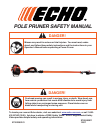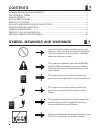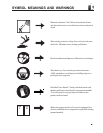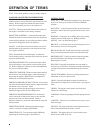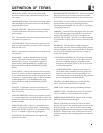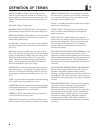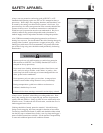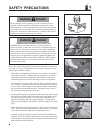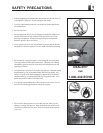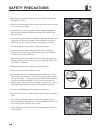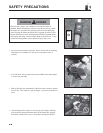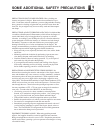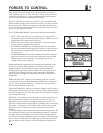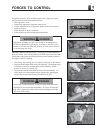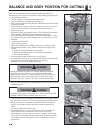
66
66
6
DEFINITION OF TERMS
PRECUT OR PRECUTTING - The two-step process to
remove a branch before the finished cut is made so as to
prevent splitting or bark tearing into the parent stem. The
branch is first undercut, then cut from the top before the
final cut.
PRUNING - Removal of plant parts.
RECIPROCATING CUTTING BLADE - A moving blade
that alternately changes direction on a linear cutting axis.
REDUCED-KICKBACK SAW CHAIN - A saw chain which
has been demonstrated to reduce kickback on some saw
models during ANSI testing.
SCABBARD - A sheath to cover the saw chain and guide
bar during transport and at other times when the pruner is
not in use.
SKATING - When the guide bar and saw chain or blade
fails to dig in during a cut, the guide bar or blade can begin
hopping or dangerously skidding along the surface of the
branch, possibly resulting in the loss of control of the
pruner. To prevent or reduce skating, properly hold the
pruner with two hands and make sure the saw chain or
blade has established a groove for cutting.
SPRING POLE - Be alert for spring poles and stay clear of
them during cutting. A spring pole can spring suddenly
when cut, or when the wood holding it down is cut away.
A spring pole can strike you or deflect the saw into your
body
STUB - An undesirable short length of a branch remaining
after a break or incorrect pruning cut is made.
STRESS FRACTURE - Structural blade or housing damage
resulting from jamming in a cut, using the guide bar/blade
as a lever, dropping the unit, or other abuse.
TERMINAL ROLE - Branch that assumes the dominant
vertical position on the top of a tree.
THINNING - The removal of a branch or branches at the
point of original or the shortening of a branch or branches.
TREE CUTTING WOUND - The opening that is created
any time the tree’s protective bark covering is penetrated,
cut, or removed. Pruning a live branch creates a wound,
even when the cut is properly made.
UTILITY - An entity that delivers a public service such as
electricity or communication.
UTILITY SPACE - The physical area occupied by the
utility’s facilities and the additional space required to
ensure its operation.
PUSH AND PULL - When cutting is done along the
bottom rails of the guide bar, the reaction on the saw is a
pull away from the operator. When the top of the guide
bar is used, the reaction pushes the saw toward the
operator. Both are normal reactions that must be con-
trolled by the operator.
QUALIFIED LINE CLEARANCE TREE TRIMMER - A tree
worker who, through related training and on-the-job
experience is familiar with the techniques in line clearance
and has demonstrated his/her ability in the performance of
the special techniques involved. This qualified person
may or may not be currently employed by a line clearance
contractor.
QUALIFIED TREE WORKER, PERSON, OR PERSONNEL -
Person(s) who, through related training and on-the-job
experience, are familiar with the hazards of pruning,
trimming, repairing, maintaining or removing trees and with
the equipment used in such operations, and have demon-
strated ability in the performance of the special techniques
involved.
REASONS FOR PRUNING - The reasons for tree pruning
may include, but are not limited to, reducing hazards,
maintaining or improving tree health and structure,
improving aesthetics, or satisfying a specific need such as:
removing diseased, dead, dying, decayed, interfering or
obstructing branches; training young trees; and, utility
line clearance. Before pruning, the primary objective
should be clearly defined. That objective should be
accomplished in the manner most beneficial to the health
of the tree.



